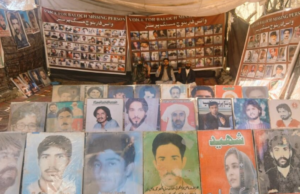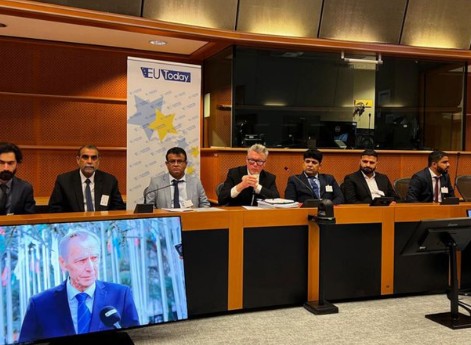
The latest Global Water Security Assessment report released by the United Nations paints a stark and sobering picture of Pakistan’s growing water woes.
Classifying the country as “critically water-insecure,” the report thrusts Pakistan’s long-simmering crisis into the global spotlight, reinforcing what experts and environmentalists have warned for years: Pakistan is inching dangerously close to a water catastrophe.
This classification is not merely a statistical label—it is a dire alarm bell.
Being “critically water-insecure” indicates that the availability, accessibility, and quality of water in the country are not just compromised, but failing at levels that threaten health, livelihoods, and national stability.
For a country of over 240 million people, this places an unsustainable strain on agriculture, industry, urban life, and rural communities alike.
Harsh reality behind numbers
Water scarcity in Pakistan is not a distant threat; it is a lived reality for millions.
According to the UN assessment, the per capita water availability in the country has plummeted to levels far below the internationally defined water scarcity threshold.
This is due to a combination of factors, including population growth, mismanagement of resources, inefficient agricultural practices, poor water infrastructure, and the looming impacts of climate change.
The Indus River system, Pakistan’s primary water source, is under immense pressure.
Shared with India under the Indus Waters Treaty, the river and its tributaries are lifelines for Pakistan’s agrarian economy.
But poor water governance, excessive withdrawals, sedimentation of dams, and over-dependence on surface water have turned a once-mighty system into a fragile network.
Meanwhile, groundwater—the fallback resource—is being depleted at an alarming rate due to unregulated extraction.
Climate variability has only compounded these issues.
Glacial melt in the north, shifting monsoon patterns, and increasingly frequent droughts have created a volatile water supply system.
Urban centres like Karachi and Lahore routinely face water shortages, while rural regions suffer from erratic irrigation cycles that jeopardise crop yields and food security.
Crisis rooted in governance
Perhaps more troubling than the environmental constraints is the chronic mismanagement of water resources.
For decades, Pakistan has struggled to implement effective water policies or build robust infrastructure to cope with its needs.
Successive governments have failed to prioritise long-term planning, often succumbing to ad hoc measures and politically driven short-term fixes.
The country’s water storage capacity is alarmingly low—estimated at about 30 days of storage, far below the recommended 1,000-day capacity for water-stressed nations.
Ageing and inefficient canal systems leak a significant portion of the water meant for irrigation, and there is little oversight or reform of water pricing and usage.
Additionally, the absence of a centralised water management authority has created jurisdictional overlaps and policy fragmentation among federal and provincial entities.
Corruption and inefficiency further erode trust and effectiveness.
Funds earmarked for water development projects are often misappropriated or delayed.
Environmental laws are weakly enforced, and public awareness around water conservation remains minimal.
All these factors have created a policy vacuum where the crisis continues to deepen.
Societal and security implications
Water insecurity does not exist in a vacuum—it has far-reaching implications for public health, food security, economic stability, and even national security.
In many rural areas of Pakistan, especially in provinces like Balochistan and Sindh, water scarcity has become a root cause of social unrest, migration, and intercommunal conflicts.
Farmers, deprived of sufficient irrigation, are forced to abandon their lands, leading to rising urban migration and putting pressure on already stretched city infrastructures.
The health impacts are equally dire. Contaminated water supplies have led to a rise in waterborne diseases such as cholera, hepatitis, and typhoid.
According to UNICEF, nearly 70% of households in Pakistan drink bacterially contaminated water, contributing to high infant mortality and stunted growth among children.
Economic implications are profound. Agriculture contributes around 19% to Pakistan’s GDP and employs nearly 38% of its labour force.
With unreliable water supply and decreasing productivity, the sector faces an uncertain future.
The textile industry—another major economic pillar reliant on water-intensive processes—also faces increased operational risks due to erratic water availability.
On a geopolitical level, the shared river system with India has been a longstanding source of tension.
While the Indus Waters Treaty has held for over six decades, the deepening water crisis in Pakistan adds another layer of vulnerability.
Any disruption or perception of inequity in water flows could inflame nationalist sentiments and exacerbate cross-border tensions.
Urban-rural divide and gender impact
The water crisis affects different segments of the population in different ways, often deepening existing inequalities.
In urban areas, those who can afford private water tankers or bottled water are able to shield themselves from the worst effects, while the urban poor—living in informal settlements—are left to scramble for limited and often contaminated municipal supplies.
In rural areas, women bear the brunt of water scarcity.
In many communities, women and girls are responsible for collecting water, often walking several kilometres to reach distant wells or streams.
This not only affects their health but also limits their educational and economic opportunities.
The lack of safe and accessible water also exacerbates gender-based vulnerabilities, particularly in crisis or conflict zones.
A ticking clock
Pakistan’s water crisis is often described in hypothetical terms—“will face shortages,” “could become water-scarce”—but the UN’s classification signals that the country has already crossed several critical thresholds.
The crisis is not looming; it is unfolding in real time.
What makes this situation particularly alarming is the lack of urgency with which it is treated at the national level.
Despite repeated warnings from domestic and international experts, water rarely features at the top of political agendas.
Infrastructure projects are delayed or underfunded, public awareness campaigns are sparse, and systemic reforms remain elusive.
The window for action is rapidly closing. While some nations have used crises as a catalyst for reform and innovation, Pakistan appears caught in a cycle of reactive policy and institutional inertia.
The longer the country waits to confront its water insecurity, the more devastating the consequences will become—for its people, its economy, and its future. As the UN report makes clear, the world is watching—but it is up to Pakistan to decide whether this classification will serve as a turning point or just another ignored warning on its descent into deeper scarcity.






